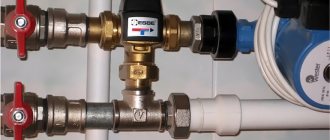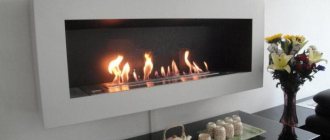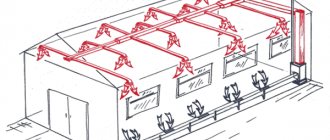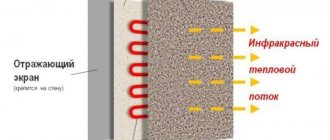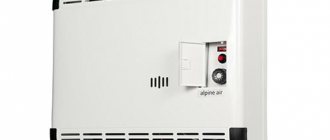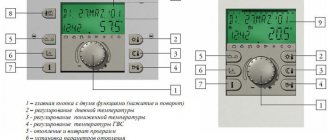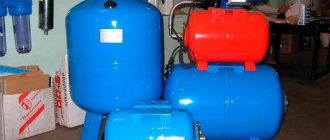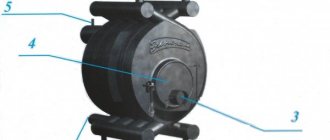Pros and cons of a gas infrared heater
Any technique (device) has its advantages and disadvantages - nothing is perfect in the world. Clear advantages of infrared heaters:
- Compactness.
- Reliability.
- Economical. If we compare them with their electrical counterparts.
- Efficiency (efficiency factor) reaches 80%.
- Safety provided that basic operating rules are followed.
There are also disadvantages:
- Open fire.
- Combustion of oxygen.
- Combustion products are released.
The third point “needs” special attention - the need for effective ventilation is simply necessary in a heated room.
Principle of operation
The operating principle of such a device is simple and clear:
- It emits infrared waves, creating a heat vector in front of the device itself.
- The air in the room already warms up from surrounding objects and people after some time - the area is heated, but not the volume.
There are a huge number of models of such devices; there are some differences in the principle of operation and power.
Sergey Yurievich
Construction of houses, extensions, terraces and verandas.
Ask a Question
All devices, regardless of differences, operate on either liquefied or natural gas.
Types of gas infrared heaters and their characteristics
Heaters are divided (according to their operating principle) into categories:
- Infrared. These gas heaters can produce heat by burning a fuel (gas), but also by using catalytic oxidation. Some models, creating thermal radiation, provide convection - this helps to quickly warm up heated rooms.
- Catalytic. They operate on the principle of gas oxidation - natural or liquefied. Characterized by the absence of flame. Heat is generated through a chemical reaction. The gas entering the catalytic panel is oxidized, and this contributes to the generation of heat. Heating is carried out using infrared, convection or mixed operating principles.
- Convection. Here there are the most ordinary burners in which gas combustion occurs. The air is heated through specially designed finned radiators. Heated air rises, and cold air masses come in its place (convection). After some time, the room becomes warm.
The modern market is replete with a choice of heaters, the principle of their operation is different, as is the scope of application.
Infrared
The source of gas is cylinders or a gas line, and the devices themselves are divided into portable or stationary.
They are presented in the form of heat guns or convectors, which are used as the main heat sources and are mounted permanently. These devices are large in size and have high performance. Their indoor use requires a chimney to remove gas combustion products.
These heaters can be used not only indoors, but also for open areas:
- Children's and sports grounds.
- Country verandas.
- Areas near the swimming pools.
- Terraces of restaurants, cafes.
- Verand et al.
Thanks to the generation of infrared radiation obtained by burning gas, the radiating elements are heated, which heat not the air masses, but the objects that are located around. This allows for gentle heating of rooms and open areas.
The generation of infrared radiation occurs due to heating elements - metal and ceramic, and the directivity is provided by built-in reflectors. This design makes it possible to heat objects located within a radius of up to 6 meters.
The fuel can be gas - both natural and liquefied. The second one is more often used - packaged in cylinders, and such equipment is classified as mobile (portable). Some models have built-in 27 liter cylinders.
If you still plan to heat the premises, then it would be more reasonable and justified to connect to the gas main. Clear advantages of infrared heaters:
- High efficiency. It is possible to heat large areas and volumes.
- Autonomous work. Most devices do not need to be connected to the mains.
There are also disadvantages:
- The device burns oxygen. Ventilation of the premises is required (which does not save fuel at all), but effective ventilation is preferable.
- Fire safety is low. Such heaters often cause fires.
Some devices heat not only by thermal radiation, but also by convection. It is this scheme that significantly speeds up the heating of the room.
Infrared gas heaters are the only devices of their kind that are able to warm up open areas.
Catalytic
Their main purpose is temporary operation, or from time to time. Such devices are characterized by much smaller dimensions and relatively low productivity. As a rule, these floor-mounted devices are suitable for heating a country house or just one of the rooms, or some utility room - where there is no centralized gas main. Main advantages:
- Compactness. Their sizes are minimal.
- Silence. These devices heat rooms, as already mentioned, due to the oxidation of gas, and not due to its combustion. It is the absence of burners that ensures quiet operation of the device.
- There are no combustion products. They do not burn oxygen and do not emit harmful combustion products - carbon dioxide and carbon monoxide.
- Autonomy of work. They do not depend on the power grid.
- Economical. Characterized by minimal gas consumption.
- High level of security. There are no burners or open flames - the possibility of fire is minimal. Heat is generated due to a chemical reaction that takes place on the plane of the catalytic panel.
- Excellent heat generators. It is transmitted to the premises using convection and infrared radiation, and some models have a double heating system. The characteristics and heating speed are significantly improved in those devices that have fans, through which heat is transferred faster and distributed more evenly.
Despite the absence of combustion products and the safety of such devices, there is still a need for good ventilation of the premises.
Convection
Convector type heaters are increasingly in demand among consumers.
Advantages:
- Compactness
- Silence.
- Efficiency.
- Aesthetic appearance.
The principle of operation has already been briefly mentioned, and it is based on the physical properties of the air in the room, because its temperature directly affects its density. That is, cold air is heavier, and that is why it accumulates closer to the floor. And warm, in turn, is light, and therefore tends to the ceiling.
That is why in convector heaters there are holes in the upper and lower parts for the passage of air. The latter, getting inside the device through the lower slots, heats up, and comes out warm through the upper holes, towards the ceiling. More features and benefits:
- So, the convector heats and directs air flows in the room.
- To increase functionality, the body of the unit itself is made of metal.
- Since the convector body is usually relatively thin, the device is quite compact.
- Such heaters are installed not only in homes, but also in shops, workshops, production areas, etc.
- A gas device is more profitable to operate than an electric one.
- The devices are safe for people and animals and warm up rooms very quickly. Ignition is carried out using a piezoelectric element.
- The power of the device reaches 7 kW, and is able to heat an area of up to 60 m2 without additional heating sources.
- The units are equipped with thermostats located on the external panel and are easy to control - this ensures comfortable operation of the device.
Gas infrared heater: design and principle of operation
Infrared heaters differ from all others in that they heat not the air, but objects that are in their area of action. Heated objects are already heating the air. Moreover, all this is much faster and more efficient than with air heating. But we must remember that very quickly they create a comfortable temperature in a certain zone - where the radiation is directed. In a few hours the whole room will become comfortable. The specific time depends on the type of walls, the ratio of the volume of the room and the power of the unit. Compared with gas guns, the effect of gas infrared convectors lasts longer: they heat the walls, floor and ceiling, objects, and they, in turn, heat the air in the room.
Gas infrared heaters come in different shapes and types, but the principle of operation is the same for all. The main element is a ceramic plate with many small holes. Ceramics are special, which when heated to a certain temperature emits heat in the infrared range.
Infrared gas heater: operating principle
Gas is supplied to the device inlet, where it is mixed with atmospheric air. At the outlet of the mixer, a flammable gas-air mixture is obtained, which is supplied through a diffuser to the ceramic stove. Ignition occurs using electric or piezo ignition - depending on the type of model and automation. Since gas is supplied over the entire area, it warms up all over, heating more or less uniformly. The temperature of the radiating surface is 550-800°C.
A high-quality gas infrared heater is absolutely safe
What distinguishes a gas infrared heater from other gas appliances is the temperature at which combustion occurs. Since it is very high, there is a very small amount of combustion products. With normally functioning ventilation, the concentration of harmful exhaust does not reach critical levels. And if this happens, the gas analyzer turns off the gas supply. If the gas infrared heater turns off, the best thing to do is to ventilate the room, wait a while, and then try to start the unit again.
How to choose a gas infrared heater (what you need to pay attention to when choosing)
A modern gas heater is an effective device that is successfully used for heating any type of premises. In addition, outdoor areas are also successfully heated.
Selection tips:
- When planning to purchase a gas heater, you need to make the right choice so that the device copes with the assigned tasks and money is not simply thrown away.
- The first thing you need to take into account is the power of the selected model. According to experts, 1 kW of power is able to heat an area of 10 m2.
- In order to effectively heat an open area, it is better to buy a device that looks like a tall lamp - these are the ones that provide a circular heating zone, which allows you to heat terraces, verandas, areas near swimming pools, playgrounds, etc.
- In order to heat the utility room, a floor-standing model is suitable.
- Catalytic models are suitable for all kinds of premises. including residential ones, since their work is safer for others.
- For large premises and if there is a gas main in the house, it is worth taking a closer look at stationary gas convectors. These heaters look aesthetically pleasing and successfully replace standard heating radiators.
- The choice should also be made taking into account the time people spend in the room. If their presence is periodic and not constant, then catalytic models are quite suitable.
- For regular heating, especially if there are children, wall convectors are preferable. When installing them, it is necessary to make a hole in the wall for a coaxial pipe, with the help of which both air intake and gas removal are carried out. True, to carry out such installation a project is needed.
- In the garage, ceramic models are an excellent source of heat; they emit infrared radiation, which transfers heat to surrounding objects.
- When going on a hike, it would be the height of frivolity not to take with you a compact heater, which is also used for both heating and cooking. Such a heater must be compact, lightweight and efficient - a tent holds heat very poorly.
In order to save a little on your purchase, you should compare prices in online stores, for example, or visit sales. The best time to purchase such a device is summer.
Advantages
The principle of operation of the heater is in infrared radiation, which is similar to heat from a conventional stove or from the sun.
It is absolutely harmless , but provided that the wavelength of the heater matches the range of infrared waves emanating from the human body.
Devices are distinguished by area of influence. Some models are designed to heat small rooms up to 20 square meters, others are designed for large rooms - up to 60 square meters. m. Consumer reviews about them are mostly positive.
Users note the following advantages of gas equipment:
- Autonomy. The infrared heater does not require an electrical connection . It runs entirely on gas supplied from small or large cylinders, a couple of which you can take with you outdoors.
- Mobility, does not take up much space. The cylinder is built into the heater itself. Some models have wheels for transportation.
- Aesthetic appearance. Can be used as the main heating in a private home.
- Several security systems that turn off the device in case of malfunctions.
- Economical. Heats up objects within the range that tend to give off heat.
- The presence of a thermostat that regulates the temperature and periodically turns off the device.
- It can be connected both to an autonomous fuel source and to a gas pipeline with natural gas.
- They are used in rooms where it is forbidden to openly light a fire due to the presence of explosive substances: workshops, garages, fertilizer sheds.
This is interesting! The easiest way to heat a house is to run gas. It serves as a source of heat and is less expensive than other heaters. How much it costs to supply gas to a private house is described in our article.
The disadvantages include:
- the need for annual preventive cleaning, since the use of liquefied gas leaves black residue;
- since the device burns oxygen during operation, periodic ventilation of the room is required to replenish fresh air and remove carbon dioxide;
- high price;
- expensive repairs if the device fails.
Repair may be required if the operating rules were not followed or the device was not properly prepared for the next heating season. The high cost is due to the complexity of the design and the quality of materials for manufacturing. Otherwise, the product has a long service life and is absolutely safe for health.
The infrared heater does not require an electrical connection.
How to make a gas infrared heater for a garage with your own hands
Not every user is ready to shell out their hard-earned money to purchase a small heater, which will greatly simplify the life of a car owner in his own garage during the cold season. Of course, after all, independent car maintenance, as well as its repair, require at least relative comfort.
In rare garages, heating was initially planned, which is why something has to be thought out later, closer to winter, as a rule.
Not every car enthusiast, as already mentioned, wants to spend money on an expensive device that will be used occasionally, and many car owners in our country are real “handicraftsmen”. Fortunately, in my own garage there are tools and some materials that are kept in it “just in case” - that is, they have hypothetical value.
So, there are handicraft “developments” for this case that allow you to solve this serious issue.
Before manufacturing such a device, you need to understand the principle of its operation, as well as become familiar with the production and assembly procedures.
The most necessary qualities of the device:
- Easy to activate.
- Sufficient power to quickly warm up the box.
- Simple design with minimal costs.
- Device security.
Whatever heating method is used in the garage, in most cases ventilation is necessary. This is necessary because with any heating either the amount of oxygen decreases or combustion products accumulate in the air, which is a risk to human health and life.
Preparation of materials and finished parts for the production of a garage heater comes down to what you need to prepare:
- You need to purchase (if not available) a burner with a valve.
- Sheet of tin.
- Scissors for cutting metal.
- Drill and set of drills.
- Rivets with a riveter.
- Fine mesh steel mesh to make a lattice. It can be replaced by an old mesh small-sized colander.
- Collet cylinders. Their convenience lies in the fact that the contents cannot be consumed all at once due to shut-off valves. As an option, it is not necessary to use cylinders for gas lighters, but a small country cylinder, for example.
Manufacturing itself:
- The heater must be fixed to the burner. To do this, you need to draw protruding ears on four sides, one of which will be twice as long as the other three.
- The blank is cut along the intended contour. Carefully cutting with metal scissors, excess material is put aside as unnecessary.
- The burner must be screwed to the workpiece using bolts.
- The ears are bent in the other direction and are used to secure the mesh.
- The strainer, already fixed, is initially made in the shape of a dome - this will allow the heat to be evenly distributed to the sides.
- To secure the second mesh, another sheet of tin is taken, and a circle of the same size with the same ears for attaching the mesh is cut out in it.
- Stepping back from the edge 5 mm. 10 holes are drilled in a circle - they will serve as a nozzle for the flame.
- A strip of length equal to the diameter of the already made tin blank is cut out of a piece of fine mesh.
- The ears are bent on all sides, using mesh strips to fix them, while the second workpiece is fixed on the opposite side.
- The round shaped ears of the blanks (already bent) are attached to the opposite ends of the strip by means of rivets using a rivet gun.
When already assembled, the structure is a kind of cylinder with walls made of mesh and ends made of tin.
The two mesh design is advantageous in that the heating surface is increased and has additional protection.
Now all that remains is to turn on this heater and test it in action. The heat will be enough to heat a garage or even a small room.
TOP 4 most popular manufacturers
By buying cheap models of heaters, the future user dooms himself to wasteful expenses: such devices are inexpensive because they are made of not very high-quality materials. Below is the TOP of the most purchased brands that have earned an excellent reputation for their reliability, efficiency and durability.
Hyundai
Hyundai is among the TOP of the world's largest manufacturers of such heaters. Excellent assembly, excellent design, safety and ease of use, efficiency - these are the main criteria of this famous brand.
Best models:
- HYUNDAI H-HG2-23-UI685. Ceramics. Power – 2, 3 kW, floor-standing. Heating area – 23 m2.
- Hyundai Geiser UI577. Gas ceramic heater. The unit is universal, it can be used to heat a garage, cottage, auto repair shop, etc.
- HYUNDAI H-HG3-25-UI777.0. The inexpensive device is suitable for use both on a camping trip and in a garage or greenhouse, where the area does not exceed 25 m2. You can install a grill grate (included), which increases the functionality of the device, turning it into a camp stove - you can brew coffee, fry sausages. Gas consumption – 218 g/hour. Folding legs and low weight (1 kg) give the model mobility.
- Hyundai Geyser. Powerful premium gas heater. It is intended for industrial heating. Piezo ignition, gas supply control, instant shutdown when tipping over. Power – 4.2 kW, heating area – from 30 to 60 m2.
- Hyundai Gasoline. Combines compactness and convenience. High mobility. Vertical and horizontal working position is provided (tilt up to 60°). You can cook food in addition to the main function.
- Hyundai HG3. A simple and convenient heater. Cross-shaped legs, grill grate (for cooking). Additional nozzle for using main gas. Ceramic burner, turning off the gas supply when the flame goes out. It is suitable for a summer residence or on vacation (in nature).
Neoclima
Neoclima is a manufacturer of all kinds of equipment according to European standards. Innovative technology, beautiful design, excellent performance.
- Neoclima UK-02 Power 2.5 kW Ceramics, heating area – 24 m2. Floor installation. Gas consumption - 0.1-0.3 kg/h.
- NeoClima UK-04. Designed for a terrace or open veranda. Maximum power – 3.7 kW, heated area – 37 m2. Ceramics, floor version.
- NeoClima UK-20. Designed for open air. Convenient, economical, highly effective. Heating elements – ceramic panels.
- NEOCLIMA 09HW-B – model for the street. Its power is quite high, the range is up to 5 m. The operating temperature is reached almost immediately. There is a fall sensor and an emergency protection system. The case holds a 27 liter cylinder. Simplicity of design, affordable price, and good characteristics allowed this heater to be included in the rating. Heating area – 20 m2.
Elekon Power
Elekon Power produces high-quality equipment and is a leading company in the Russian market. It's been almost 20 years now. The best models of gas heaters:
- ELEKON POWER PG4B. Tourist heater. Fuel - tall (collet) cylinders. Power – 1 kW. Operating time from a 220 g cylinder is 3.5 hours. Consumption – 0.056 kg/hour. Piezoelectric ignition. Mobile camp stove. Operating temperature – minus 10-plus 40 degrees.
- TT-30S Elekon Power. Power – 8.8 kW, weight – 3 kg, gas consumption – 0.44 kg/hour. Piezo ignition. Compactness.
- Elekon Power PG7B. Gas stove with a power of 0.9 kW. Weight – 0.6 kg.
- ELEKON POWER TT 30S. Runs on liquefied gas. Connects to a 5-50 l cylinder. At maximum power it consumes 1l/hour. Power – 6.5-9 kW (adjustable). Quiet in operation, ignited by a piezoelectric element. Suitable for use at the dacha, picnic, fishing, construction site, etc.
- Elekon power PG3B. Tourist, for tents and small spaces. Highly appreciated by hunters and fishermen, tourists. Powered by gas cartridges (enough for 3-5 hours), which is a very economical indicator.
Ballu
The Ballu concern has a strong presence in the markets of Eastern Europe, Russia, and the CIS. Produces thermal curtains, guns, convectors, etc.
Best models:
- Ballu BOGH-15. This is the best model designed for street use. Optimal performance characteristics. Heating radius – up to 3 m with an area of 28 m2. Safe operation.
- Ballu BIGH-55. Heats a room up to 60 m2. Quiet in operation, combines infrared radiation and convection.
- Ballu BIGH-3. Weight – 1.5 kg, power – 3 kW, heating area – 30 m2. In addition to heating, you can also cook food. Heat-resistant enamel increases the life of the heater body. Supplied with a 1.5 m hose and reducer. There is a temperature sensor and tilt control. Ceramics. The design feature is a burner rotating on legs, equipped with a mesh. You can cook food in a horizontal position.
| Name | Power | Heating area | Size(mm) | Weight, kg) | Average price (2019) |
| Big 4 | 4500 | 60+ | 270 (length) | 2,8 | 2800 |
| Ballu Bigh 3 | 3000-4500 | 45 | 338/278/372 | 2,3 | 2400 |
| Pathfinder Hearth | 1500 | 15 | 275/275/180 | 1,8 | 3000 |
| NeoClima UK-2 | 2500 | 25 | 192/150/86 | 1 | 1300 |
| Master 34 CR | 3400 | — | 160/350/460 | 2,6 | 2200 |
Price
The cost of these devices is relatively low and even very affordable if you compare its price against the background of what we get as a result. For example, the Prometheus infrared gas burner costs about 800-900 rubles on the Russian market. A whole gas stove with a set of such devices costs about 3-4 thousand rubles.
2016-05-17 4 623
Mobile infrared gas ceramic heaters Prometheus are designed to operate on mains or bottled gas. The model is especially popular among fans of fishing and hunting.
Gas heater for a summer house
It is much more profitable to warm up a country house in Russia with gas than with electricity or a diesel generator.
The conclusion suggests itself - all that remains is to choose and buy a gas heater.
For heating a country house (in the absence of a gas main), a mobile device is most suitable. Causes:
- There is no need for radiators or pipes, without which there is no expensive water heating. In addition, the water must be drained in winter to prevent the entire system from defrosting.
- When staying at the dacha from time to time, it is quite reasonable to take the heater home each time, or hide it in a secluded place and under lock and key, in order to avoid theft of the device.
- Small size of the device and its mobility. If there are several rooms in the house, then it is not always necessary to warm up all the rooms. An underfloor heater on casters will simply solve the problem.
- Technologies are safe and effective. In addition, they have pressure sensors. This is how the gas supply is controlled, and there is also an automatic shutdown system.
- The small size of a gas heater is a big plus for its trouble-free storage in a small area, or its transportation home from the dacha and vice versa.
- Economical. Such devices are characterized by low gas consumption thanks to modern technologies.
- Environmentally friendly. Most devices do not dry out the air and do not burn oxygen.
- Autonomy. There is no dependence on gas supplies. You just need to stock up on a couple of extra cylinders, and there are gas stations everywhere now. Most of these devices do not require power supply. Unless of course it is a convector with a fan.
- Power control option. By switching modes, you can regulate the temperature in the house and significantly save gas. If the device is portable, then it can also be used on picnics, for example.
- Durability. Since high-quality materials are used in the production of these devices, they are highly resistant to humidity and high temperatures. The device, taking into account not constant workload, can be used for several decades.
And yet, if the operating rules are neglected, a fire is possible. In addition, many models involve the installation of exhaust ventilation.
Types of heaters recommended for summer cottages:
- Gas convector devices. Many of them have fans. It is they who contribute to the accelerated movement of air. This ensures uniform heating of the rooms.
- Heat guns. These are quite powerful devices that very quickly warm up the air, both indoors and outdoors - on terraces and verandas. In addition, thanks to this gun you can dry the basement and walls after a flood. In this way, you can also speed up the ongoing construction and finishing work or save your own garden during the flowering period from sudden frosts. A stable temperature can occur both in rain and in strong winds.
- Catalytic heaters. This solution is completely environmentally friendly, since combustion, as already mentioned, occurs without a flame. The efficiency of the device is also quite high and allows you to heat fairly large rooms. Having purchased a portable heater of this type, you can also use it on hikes.
By and large, you can study the model range before purchasing, as well as reviews for each model.
Advantages and disadvantages of heating with a catalytic heater
Before you buy a catalytic heater, you need to understand all the advantages and disadvantages of this heating method.
Advantages of a catalytic heater:
- A catalytic heater for a summer house or home does not have a negative effect on the microclimate of the room. It does not disturb the natural balance of oxygen and carbon dioxide and does not emit harmful substances that are usually formed during the combustion process, thus maintaining a healthy microclimate;
Catalytic gas heaters are environmentally friendly and safe devices
- The device is much safer than traditional gas ones, since there is no danger of poisoning due to excessive carbon monoxide release. In addition, there is no risk of fire. Such a device can be used without fear in a home, a tent, or an industrial workshop;
- Another important advantage is the ability to regulate the power of the device. This allows you not only to maintain a comfortable temperature, but also to save significantly;
- mobility – even large and powerful devices can be moved quite easily, not to mention compact heaters. According to device owners in reviews, catalytic heaters often easily fit into a bag or backpack.
Despite the abundance of significant advantages, catalytic heaters are not without disadvantages:
- such devices have a fairly limited operating period - about 2500 hours. The fact is that during use the catalyst gradually burns out and after a certain time it needs to be changed. The amount is approximately 2/3 of the cost of exactly the same new equipment, so it’s easier to throw away the old device and buy a new one;
With small dimensions, a portable catalytic heater can easily heat a small room or tent
- The quality and life of a catalytic heater directly depend on how well purified fuel you use. Low-quality gasoline or technical alcohol will very quickly render the device unusable.
